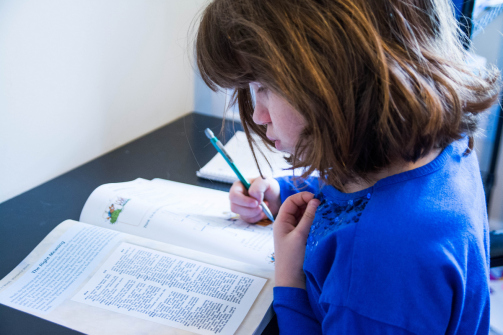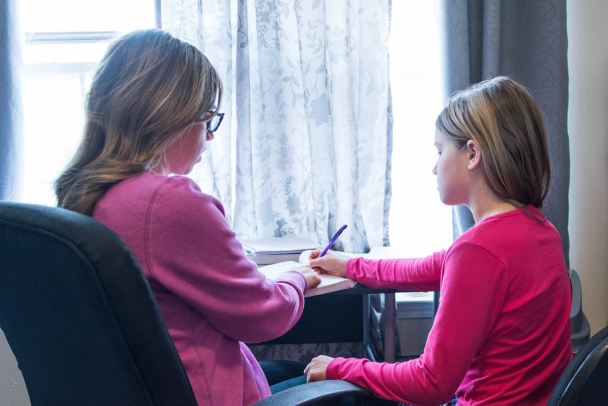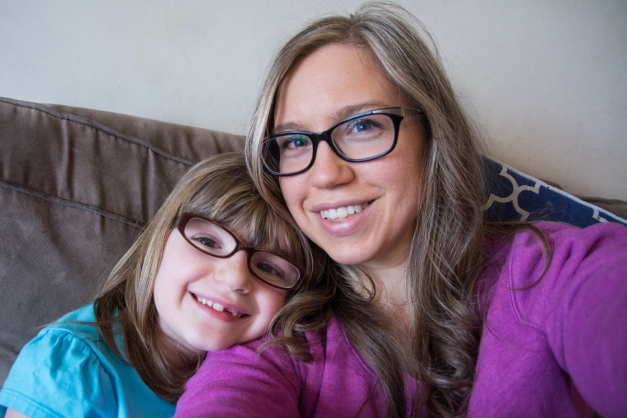One of the great things about homeschooling is that we can conform teaching methods to fit the individual student. I’ve always recognized that my children are unique from one another, but recently I’ve been noticing afresh how their personalities affect their styles of learning, as well as how mine affects my teaching.
My oldest, “Daisy,” is probably most similar to me in how she tends to learn. She is a willing recipient of one-on-one instruction, and she often processes new information by repeating things back to me or giving examples in her own words. She is a bit impatient about how long her homework takes her, though it really doesn’t take that long—provided she doesn’t get too distracted.
Daisy has an excellent memory for what she learns, but tends to forget to follow instructions carefully, causing errors and omissions that often make her quite upset. She has a fear of failure which can cause her to become overwhelmed and want to run the other way when faced with a difficult assignment, but I’ve found that by urging her to keep going and showing her how far she’s come, she generally does quite well.
My middle daughter, “Ginger,” is more like her dad: a very independent learner. At the age of 4, she took it into her head that she was going to learn to read . . . and so she did, mostly by herself. A year later, she decided she wanted to work through a kindergarten book even though I was busy with a new baby and wasn’t ready to give her instruction. She did the majority of it over the course of a few months, quite the feat of self-motivation. Unfortunately, she didn’t bother to ask when she had questions, and thus had to re-do quite a bit of her work.

This habit has persisted to this day, except that now I don’t let her go more than a day or two without looking over her work and providing necessary instruction. On the one hand, Ginger’s independence is great. She is very bright and can often be told to “read the lesson and then do the work” without any further instruction. When she doesn’t understand something, however, it can cause a good deal of consternation during our teaching session as I try to explain the concept or show her the proper method. She doesn’t like to have to listen to me; her preference is either to make something up on her own or declare it impossible.
These moments can become quite frustrating to me, when the same child who recently finished a 700-page novel suddenly can’t remember how to divide 6 in half. I’ve often attributed this to laziness, but I think what I’m beginning to understand is that she relies so heavily on her intuition that she gets easily flustered when she doesn’t intuitively understand something. She needs to learn how to calm down and use her head. I’m still pondering the best way to help her do that in such moments, but I’ve at least learned (the hard way) that giving her a lecture on laziness is the wrong way to go.
Meanwhile, “Sweet Pea,” my third, is almost the complete opposite. While Ginger would prefer to do the work on her own, Sweet Pea would rather have me giving her one-on-one instruction for everything. She has always craved this kind of personal attention, so I guess it should come as no surprise that this is the way she wants to do school. She is always chatting with anyone who will listen, asking dozens of questions, and soaking up information like a sponge. She is clearly a more social learner, and while she’s an excellent reader, she seems to thrive on learning through conversation.

Her learning style has probably taught me more about myself than anything else. While her one-on-one sessions tend to go more smoothly (because she loves them), I find it frustrating and exhausting sometimes that she wants me to do things with her instead of figuring them out herself, and that she asks so many questions in any given day. As an introvert, I value my alone time, and she always seems to be popping in to ask a question, or tell me that she’s bored, or ask me to read her a book, or even randomly say hi! There are some days I end up telling her that I can’t handle any more questions for a while and need to be left alone.
With the different personalities of all the children and teachers out there, it’s a wonder to me that one teacher is expected to handle a whole room full of individuals in traditional school. I find it challenging enough with only three full-time students! It’s an adventure for sure—but worth of the effort. It can be a struggle sometimes to find the balance between working with the child’s personality / learning style while also recognizing the need for a system that works for both me as a teacher and us as a family. But I believe this tailored approach can provide an ideal learning environment for our children. It’s one of the major reasons we’ve chosen this path!

One final note: I’ve found it surprisingly helpful to write out these descriptions of my children’s personalities and learning styles. Even though I knew these things in my head, I can see things from a different perspective when I actually put them into words on paper. This is a part of my learning style! If it’s helpful for you, too, I’d love to hear: What are your children’s learning styles?
—Jessica
Photo Credit: Graphic design by Anna Soltis. Following images by Jessica Cole.

